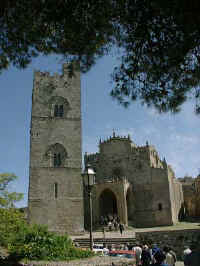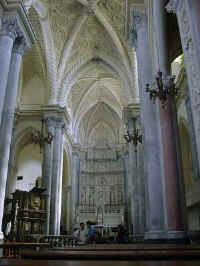|
Page 1 2 3 4 5 6 7 8 9 10 11 12 13 14 15 16 17 Saturday, 7 April. After the buffet breakfast in the hotel, we boarded the bus at 8:30 and headed for an optional tour of Segesta and Erice. Both are in Trapani province, past Palermo on the very northwest corner of Sicily. Both of these towns were founded in the 12th century B.C. by a Middle-Eastern people believed to have been Trojans fleeing the Greeks after the Trojan War. In the 5th century B.C., they formed an alliance with Carthage against the Greeks on the southern coast. Eventually the Greeks prevailed, and in 307 B.C. they razed Segesta to the ground. The only structure spared was a huge unfinished Doric temple. It probably was spared because it was almost completely covered with earth, and the Greeks would have had to dig it out to destroy it. The temple sits on a hill above Segesta and wasn't buried by any natural phenomenon. Rather, it had been covered with earth as part of the normal building process of that time. First the floor of a building was laid; then the first section (drum) of each column was rolled to its place and set down. The entire structure was covered with earth to the top of those truncated columns. The next drum of each column was rolled across the packed earth to its place and set down. And so the process continued until the entire temple was completed, but was also buried. It was at that point that the Greeks destroyed Segesta. When the Romans occupied Sicily, they resettled Segesta (rebuilding it entirely in Hellenistic style) and dug out the temple.
Unlike most Greek-style temples, this one hasn't fallen down and been reassembled. It is in a remarkable state of preservation. Fortunately, it was too far from any urban development to have been useful as a quarry. Although it wasn't built by Greeks, it certainly seems to have been copied from the Greek temples. There are some differences, though, most noticeably the lack of the central "cell" (enclosed rectangular structure) that the Greeks always built first and then surrounded with columns. Surprisingly, our guide repeatedly referred to it as a Greek temple and never once mentioned that it wasn't built by the Greeks. We next drove to Trapani, an important trade center in the Middle Ages, but now known mostly for its huge beds for extracting salt from sea water. The bus climbed the steep road up to Erice on the top of Mount San Giuliano overlooking the city. We stopped first to visit the 14th century Mother Church, then the bus took us further up to the city center where we had lunch at the "Ulises" (undoubtedly named to show a connection with the Trojan War, but a hero of the wrong side if the town was really founded by Trojans).
After a big lunch we roamed the town. Despite the haze, we enjoyed the fantastic views.
They say that you can see Tunisia on a clear day, but we could barely make out
Marsala, less than
20 miles to the south. We also saw (from the outside) the town's two castles: Balio Castle built
by the Normans in the 12th century on the ruins of a Roman Temple of Venus; and Pepoli Castle
built later but on the remains of a Saracen fortress. At 8:00 the bus took us a short way down the road to a restaurant for dinner. By the time we finished, around 9:30, the place was mobbed, with long lines of people waiting for tables. We were glad we had the "early seating." During the night there was a heavy rain, the first rain since our arrival in Sicily. Page 1 2 3 4 5 6 7 8 9 10 11 12 13 14 15 16 17
Copyright © 2000-2023 DarrellPeck.com All rights
reserved. | |||||||||









